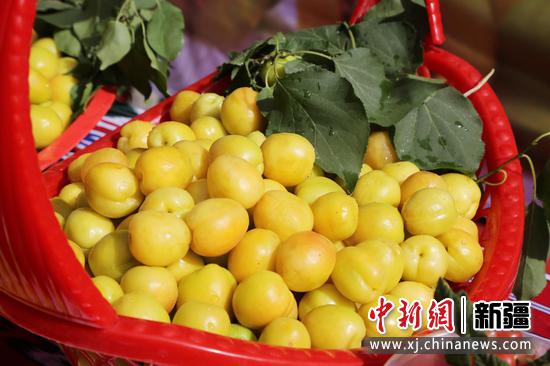Rural residents in NW China’s Xinjiang embrace better life thanks to the region’s multiplied efforts
Living standards in rural areas of northwest China's Xinjiang Uygur Autonomous Region have been significantly raised these years, thanks to the region’s endeavor to develop industries with local features, improve the living environment and infrastructure in rural areas, and cultivate talents.

Photo shows apricots produced in Luntai county. (Photo/Chinanews.com)
The first three quarters of 2021 witnessed a year-on-year increase of 11.5 percent in the per capita disposable income of rural residents and an increase of 6.9 percent in the added value of the primary industry in Xinjiang.
Luntai county of Bayingolin Mongol Autonomous Prefecture started to build demonstration parks for small white apricots in 2018, while Taleke village in the county, which used to produce low-quality apricots due to a lack of sufficient techniques and experience, held training sessions on cultivating apricot trees and invited professionals to give lessons to local villagers in the same year.
The village saw a bumper harvest of apricots in 2019. With the help of online sales channels and logistics firms, the sweet and juicy fruit has been sold outside Xinjiang. Now the village also hosts an apricot flower festival in April when apricot flowers enter the blooming season as a way to boost tourism.
Shilbam Ibrahim, an apricot farmer from the village whose family has 15 mu of land (1 hectare) for growing apricot trees, earned 135,000 yuan (about $21,195) this year. “My family built a new house. And my husband and I bought a car each,” she said, adding her life is as sweet as the apricot.
Similarly, Altay Prefecture has fully tapped its potential in ice and snow tourism. Now the prefecture is home to over 1,200 homestays, with over 3,000 local residents engaged in tourism. “Altay boasts world-class resources of ice and snow, and has organized a series of ice and snow events these years,” Mukyat Otey, head of the rural vitalization bureau for the region introduced.
Besides, Xinjiang began work on improving the living environment and infrastructure these years and started to upgrade its toilet facilities, regulate the discharge of contaminated water, clean up garbage in a timely manner and dredge waterways in 2019.
As a result, residents of Nanhu village of Hami city, who used to live in adobe houses, now live in new settlements that are comfortable and fully equipped with furniture. An asphalt road with solar-powered street lights leading to the village was also built, making the travel of villagers easier. “With the newly-installed trash cans, villagers have a higher awareness of environment protection,” introduced Arkin Abliz, a local villager.
To ensure that each village has a talent team focused on agricultural technologies, Xinjiang has cultivated agricultural talents and entrepreneurial pioneers, while encouraging those who worked and studied outside the region to come back and startup businesses.
Gheni Barat, 27, returned to his hometown of Bachu county and learned cotton planting from his father when he graduated from college in 2018. Now, he is the head of an agricultural cooperative, which has seven employees. “The cooperative installed drip irrigation systems in the cotton fields, promoted the integration of water and fertilizer, and chose cotton varieties that can be easily harvested by machines,” he said, adding that about 400 kilograms of cotton will be harvested on each mu (667 square meters) of land this year, which will generate a return of over 100,000 yuan.
Photos
Related Stories
- Stunning winter scenery at Kanas Lake in China's Xinjiang
- U.S. Xinjiang-related act based on lies, misinformation: Uygur scholars
- U.S. attempt to hinder Xinjiang’s development under guise of human rights doomed to failure
- China's Xinjiang posts foreign trade growth with EU in Jan.-Nov.
- No forced labor in Xinjiang but Western exploitation: report
- Commentary: U.S. conspiracy on Xinjiang an exercise in futility
Copyright © 2021 People's Daily Online. All Rights Reserved.










